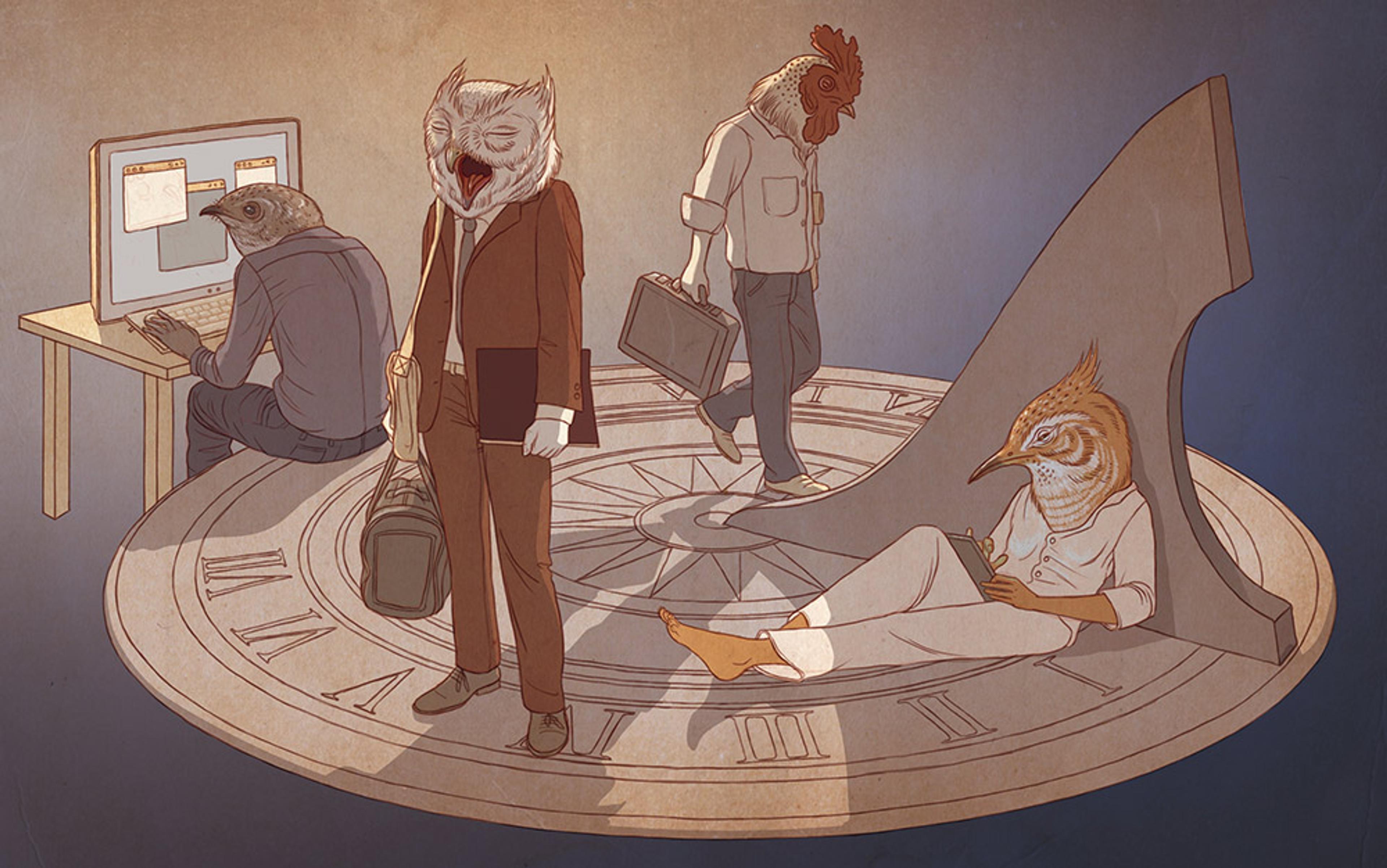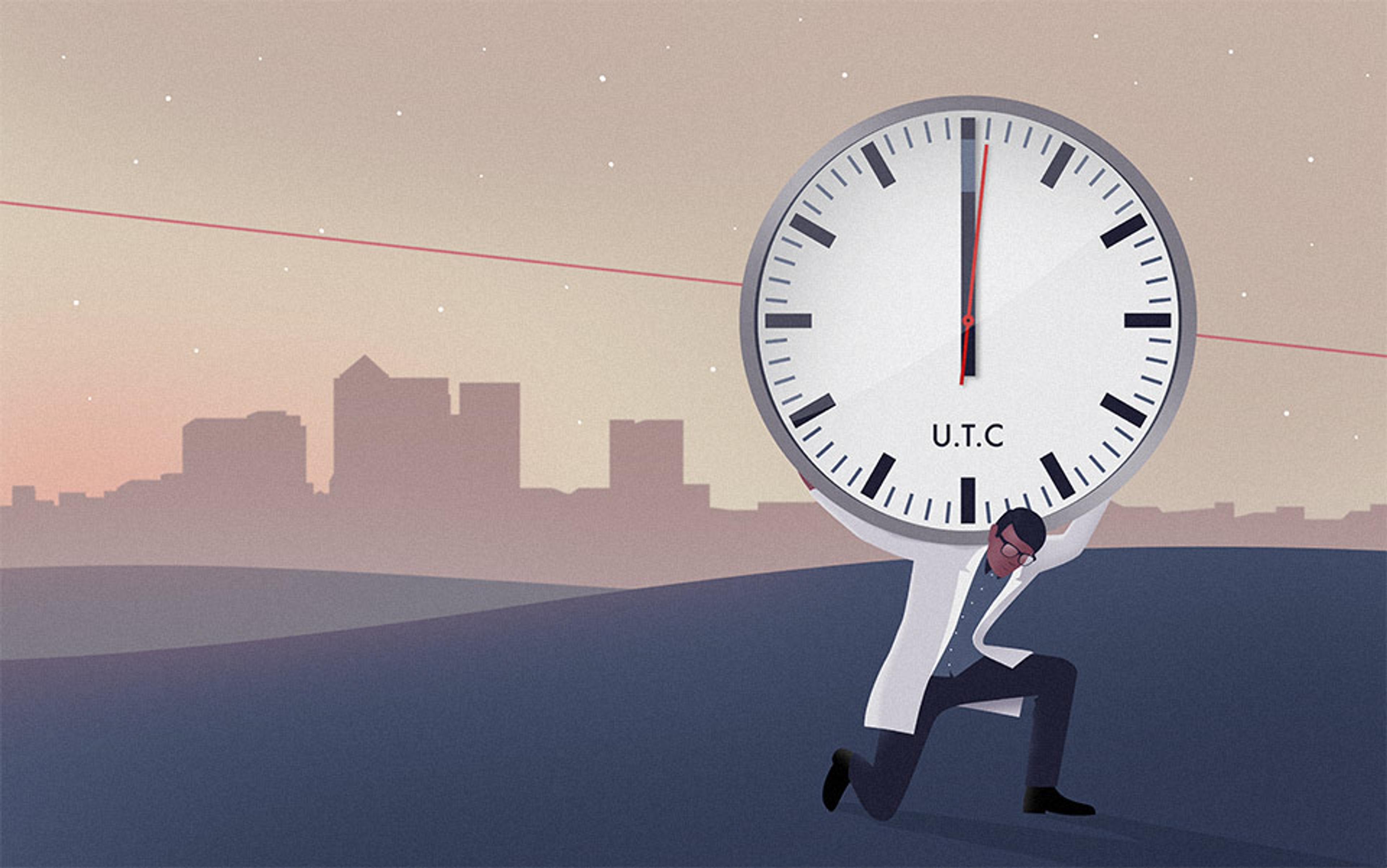It was just a regular shipment of golden hamsters from the breeding colonies, except for one male animal. While all the other hamsters aligned on the shelf in the lab of Michael Menaker, then professor of biology at the University of Oregon, showed a regular 24-hour activity rhythm, the mutant and his descendants lived by a quicker daily pulse. The 20-hour hamsters didn’t live long under 24-hour cycles of light and dark – they died of a kind of perpetual jetlag. But put them in a 20-hour light cycle, and they were fine. In some meaningful sense, the animals’ home was not Earth. They were aliens whose home planet was somewhere out among the stars, rotating every 20 hours.
All life on a rotating planet is ruled by circadian rhythms. Chronobiology research has brought the importance of healthy sleep to the fore, and we have made great strides in understanding jetlag. But if we stop there, we’re missing the larger point, which is that our bodies in all their complexity live and die by the clock. For decades now, scientists have understood that every bodily function is under the control of the bodyclock. In other words, physiology is four-dimensional – we might as well be different animals during the day than we are at night.
Plenty of good science has been done, but the applications of this research, especially in medicine, are just beginning. A particularly promising approach seeks to bring the bodyclock into the clinic through ‘chronotherapy’. While chronotherapy sounds like it might be a kind of technique for righting a circadian system that’s out of kilter, in fact it relies on a functioning rhythm for precision-guided medical interventions. Using chronotherapy, the ticking of the bodyclock can help us fight cancer, safeguard our hearts, time our meals, and even make better use of our brain’s intelligence.
The first circadian clocks originated more than 2 billion years ago, during the Great Oxidation Event. They are found in all plants and animals, and in fact are almost universal in the tree of life. The circadian system works to provide two crucial whole-organism functions, one of which has lost some of its survival value for humans; the other is maladapted to modern lifestyles and causes us untold problems.
Internal clocks help living beings ready themselves for the daily events that are important to their survival: they act as a conduit between the organism and the environment. A bat’s inner alarm clock wakes her at dusk in a cave with no other time cues, and she flies out in time to catch the crepuscular insects that sustain her. Many bacteria shut off their cell division mid-day, regardless of cloud cover, to protect themselves from harmful UV radiation.
To be fully integrated with an ecosystem, an organism must cling to its niches, and one of those is a carefully carved-out temporal niche. For example, the first mammals’ warm-bloodedness allowed for successful colonisation of the nighttime world, when reptilian systems slowed down. Two similar species can comfortably occupy the same space if they do so at different times of day. Our modern built environment provides food, warmth and light at all hours, as well as safeguarding us from nocturnal predators. Superficially, we’ve been liberated from our own niche in the day/night environment but, under the surface, that desynchrony is causing all manner of problems. We have not outgrown our need for an internal timing system – far from it.
With so much of the talk about bodyclocks focused on sleep, it’s easy to forget that all of our biological processes around the clock are organised by circadian rhythms. Every day of the internal schedule is full of appointments. Nitrogen-fixing bacteria glean oxygen from the atmosphere, and they also photosynthesise to store energy. But they can’t do both at once, so they alternate between nocturnal nitrogen-fixing and daytime photosynthesis. Mammals have many such processes to orchestrate, and just about everything our body does – from metabolism and DNA repair to immune responses and cognition – is under circadian control. In humans, normal organ functioning depends on a harmony in hierarchy: synchrony among molecular rhythms within each cell, among cells in each organ, and among organs in the body. Coordinated functioning ensures that the body doesn’t work against itself.
The human body is teeming with clocks, arranged in a hierarchy. At the helm, a master clock in the brain’s hypothalamus called the suprachiasmatic nucleus (SCN) sets the overall rhythm of the body. But each organ also has its own rhythm that’s generated internally. A clock, in the broadest sense, consists of any type of regular oscillation, and these clocks take the form of a transcription-translation feedback loop that circles back to the beginning in roughly 24 hours. Clock genes activate a process that results in protein synthesis, and once the concentration of those proteins in the cell reach a critical threshold, they come into the nucleus and turn off the clock gene that produced them. Once the proteins have broken down, the gene switches on and the cycle begins again.
liver and pancreas clocks are easily reset by eating late at night, which puts them out of sync with the rest of the body
Every day, the body corrects its clock to match its surroundings using daylight. A photoreceptor in the retina – the third photoreceptor after our black-and-white vision rods and colour vision cones – senses only overall light levels and reports directly to that master clock to reset it when it drifts off-course.
Those other clocks, some generated within the cell and others governing the workings of organs, have basically the same molecular organisation as the SCN but they are autonomous from it. They differ enormously in the extent to which their rhythms are coupled to the central clock and they can be influenced by other factors. For example, liver and pancreas clocks are easily reset by eating late at night, which overrides the SCN signals in those organs and puts them out of sync with the rest of the body. Jetlag’s groggy unpleasantness comes more from this uncoupling of clocks than from an earlier or later internal time, per se. It takes about a day per hour of time-change to reset the master clock, but it can take even longer to corral the organs into line with each other. The effects of circadian dysfunction can be disastrous in the long term – knock out the cellular clocks in just part of a mouse pancreas, for example, and diabetes quickly ensues.
We can time everything from exercise and eating to work and thinking for maximum effectiveness. The first step is to know thyself. Each of us has a circadian system that attunes us to the rotation of the planet, but your place in that eternal circle is unique to you. The way your body orchestrates its cycles is different from your son’s timing or your partner’s. For one thing, your avian type – early bird, night owl or humming bird (in between) – is a biological reality. Early birds really do have different physiologies than night owls, because morning people have shorter circadian rhythms that drive them to sleep earlier. Women are more likely to be early birds than men, and introverts are also more likely than extroverts to be up with a smile at the crack of dawn.
These chronotypes are largely genetic, but they also change with age. Young children and elderly people tend toward the morning, but toward late adolescence our cycles are shifted later in the day.
As body temperature rises slowly throughout the day, athletic performance improves and we perceive less exertion from the same workout. Many sports records are shattered in the early evening when muscle contractions are more powerful and flexibility improves (biochemical processes of all kinds tend to happen faster when body temperature is higher). Try tracking your running times – you might find they peak with your body temperature.
At the dinner table, circadian insights can tell us how to time our meals. Late in the day is when triglyceride fats are synthesised, primarily from the fat content of our meals. One of the reasons that diabetes and obesity carry a risk of heart problems is that these triglycerides build up in the heart and disrupt its contractions.
Between 10am and lunchtime, many of us perform best on logical reasoning and critical thinking
The calories consumed later in the day are more likely to be stored as fat – and compared with cardiac fat storage, the fat around our hips is the least of our worries. It’s not just fat in the heart that causes problems – fat in the liver is a contributor to diabetes and various lipid disorders.
When people eat at a time when the liver has packed it in for the night, those sugars and fats are not properly metabolised. Twenty percent of liver proteins are created in a strictly circadian fashion, so that the liver produces twice the average number overall in peak times, and half at the lowest times. If one stifles those clock genes in the liver, fat levels in that organ spike, even with a low-fat diet.
At school and the office, circadian influence is working behind the scenes. A short-term memory task, such as retaining a phone number, is better done in the morning when a low body temperature slows its erasure. Sleep pressure is usually low in the morning, too, which gives us the ability to focus without the distraction of drowsiness. Between 10am and lunchtime, many of us perform best on logical reasoning and critical thinking. But the speed of calculations peaks in the late afternoon, when higher body temperature leads to quicker thinking.
Learning is an area in which time of day is intensely influential. Our picture of the steadily building learning curve is incomplete. The same cells that take in information about what we see and hear – and where we are – also contain circadian clocks that mark down the time of that learning. This makes them more responsive in offering up those recollections at the time of day when they first encoded the memory. Exam performance on a morning class would be expected to suffer if the exam is held in the evening or outside of the regular classroom.
The joint-discoverer of that third photoreceptor in the eye, Russell Foster, professor of circadian neuroscience at the University of Oxford, sits in the private room at Zuma, a Japanese restaurant in Abu Dhabi. Across the table, Her Highness Sheikha Mariam, a young petite face peeking out of her black hijab, offers incisive comments between surreptitiously checking her cellphone. When it comes to sleep cycles, she is of the mind that if we went back to the rhythms of a few centuries ago, we would all be healthier. The discussion is surprisingly engaging, considering that most of the people at the table – including me – are jetlagged.
‘So much has been made of the so-called “sleep” hormone melatonin,’ says Foster. ‘But it’s really just a biological marker for darkness. At most, it has a slight sedative effect for some people.’
It’s October 2015, and Foster’s role as a pillar of the circadian rhythms field has become dual. He travels the world championing bodyclock research and its health benefits, while vigorously defending us all against what he calls the ‘snake oil’. He becomes visibly upset when talking about some of the cravenly irresponsible claims he’s seen – for example, a supposed link between childhood leukemia and nightlights.
Thanks to the work of Foster and other pioneers, the importance of a healthy circadian system has received growing attention in recent years, as well as the benefits of a good night’s sleep. And once that system is in sync, the real potential of the bodyclock emerges.
it has been noticed for more than 30 years that chemotherapy is more effective when delivered at certain times of day
If you know when your enemy is going to strike, you have the strategic advantage of preparation and timing. We’re not the only ones with a circadian rhythm: our microbiome has its own, and so do our diseases. That means we can pinpoint the timing of our interventions for just the moment when our pathogens are most vulnerable. No longer bathing the body in drugs throughout the day, ‘chronotherapy’ acts like a guided missile to tackle disease at its most active phase.
The most substantial body of research in chronotherapy comes from the field of cancer treatment, where it has been noticed for more than 30 years that chemotherapy is more effective – and less arduous – when delivered at certain times of day. That’s because tumours grow on a rhythmic schedule, and that schedule does not match the growth timetable of healthy tissues that might fall victim to whole-body anti-cancer drugs. Organs that oncologists normally try to isolate in space can also be separated by time differences.
The leader in this field, the French oncologist Francis Lévi, made the first convincing case that chronotherapy could work in a real clinical setting in 1990 at the National Scientific Research Centre at the Hospital Paul-Brousse in Paris. Lévi remembers his first metastatic colorectal cancer patient in a Phase II precision-timed chemotherapy trial of the anti-cancer agent oxaliplatin. Almost all of the patients had failed previous chemotherapy. He went to check in after the first five-day round of treatment and got an earful of bitterness. The patient was convinced he’d been relegated to the placebo group, with no access to real treatment. There was none of the signature nausea and pain; he hadn’t felt a thing.
‘For some anti-cancer drugs, the optimal time to deliver treatment could be in the middle of the night,’ says Lévi. ‘Chronotherapy can improve some adverse events up to five-fold as compared to constant rate infusion, and as compared to wrongly timed delivery.’
That trial, of 60 patients with advanced colorectal cancer, found that three cytotoxic drugs could be safely delivered at double the dose if a timed schedule was followed. That led to more than double the efficacy: two out of three tumours shrank to operable size in the experimental condition, whereas only one in four showed the same progress when the drug was delivered normally.
Lévi came to the study of timed pharmaceutical intervention through a study of traditional Chinese medicine, the core tenets of which are rooted in chronology – physiological differences between day and night, as well as the seasonal flare-ups of various types of ailments. Without getting too bogged down in arcane philosophy, suffice it to say that the person is understood to be tied closely with the rest of the world and, indeed, the universe. This includes a bodily response to the ebb and flow of sunlight: the climax of yang at noon, and the maximal yin at midnight.
According to Weijun Zhang of the David Geffen School of Medicine at the University of California, Los Angeles, the body is divided into 12 meridians, which map loosely onto the bi-hourly time markers of ancient China, and an acupuncturist might take the timing of symptoms into account when choosing body points to target. For example, an insomnia sufferer would receive attention to the four meridians corresponding to the hours between 11pm and 7am. In China, these traditional ideas still comprise a large part of the national medical system.
‘Keep in mind, this is a theory from 3,000 years ago, and it’s a very simplistic philosophy,’ says Zhang. ‘The main framework that is still in practice is the principle of treating a person as a whole body – a holistic approach – and as an individual who is different from other people.’
Noon and midnight are geometrically interesting, and noon represents a maximum of solar energy that a place receives, but chronobiology has not corroborated them as significant markers in human biology. If 6am and 10pm had been pegged as yin and yang peaks, we might have mapped them onto the cortisol-awakening response – a sharp spike in the stress hormone within the first half hour after waking – or the precipitous drop in body temperature that happens in the late evening. Those are the key biological transition points for us. However, the overall idea of timing opportunities in medicine is newly relevant.
For chronotherapy to work, it has to be personalised, ideally at many levels: cellular, tissue, organ and whole-body. Lévi’s team started out with an assumption that patients at all stages of their cancer have roughly similar circadian rhythms. What they actually found was a 12-hour range of chronotypes, which makes personalisation crucial – timing based solely on the hands of a clock would be essentially meaningless. The team has developed a telemonitoring system that allows a patient’s heart rate, body temperature and other vital signs to be screened automatically. Not only does it pinpoint the time of day for therapy, it also warns them when the patient is not doing well.
There are two possible strategic approaches to timing. In cancer, for example, the best time to target a tumour – when its cells are proliferating the most rapidly – does not always coincide exactly with the time when the side effects of the drug are minimised. If one opts for the maximum-efficacy approach, attacking the tumour at its most vulnerable, the short-run effects can be dramatically forceful. Unfortunately, what follows is a bizarre conundrum.
Fatigue, risk of infection and depression could be alleviated if chemo could only be delivered when the bone marrow is not producing blood cells
When anti-cancer drugs are administered at a more toxic time, not only do patients suffer from damage to their healthy tissue, but their circadian clocks are also disrupted. Of course, when internal rhythms are out of whack, timed medicine becomes harder and generally less effective. So the best long-term approach seems also to be the gentlest, letting the drugs be unobtrusive guests quietly ushering out disease, without a counterproductive attack on the timing system itself.
Among the most demoralising side effects of cancer chemo are the plunging white-blood cell counts a week or so after each treatment session. Fatigue, risk of infection and feelings of depression could be alleviated if chemo could only be delivered when the bone marrow is not producing blood cells. When a Norwegian medical team collected bone-marrow samples at various times of day, they found that myeloid progenitor cells – an early form of white blood cells – divide more than twice as vigorously between 8am and 4pm in two-thirds of men, while between midnight and 4am, blood production and DNA synthesis pack it in for the night.
Handily, a doctor doesn’t have to take an invasive bone-marrow sample to understand an individual patient’s blood-production rhythm – white-blood cell counts in circulation follow a shadow pattern with a four-hour delay, so a simple fingerprick test can indicate the safest time for chemo.
We’re going to see the prefix ‘chrono’ attached to every form of medicine before too long. Take chronocardiology: a heart attack is more likely on a Monday than on any other day of the week. It’s our behaviour that makes the day of the week a biological reality – staying up later at the weekend leads to a jarring disruption on Monday, when the workday reasserts itself again.
The morning, in particular, carries danger for a cardiac event. Tami Martino runs a chronocardiology lab at the University of Guelph in Canada and studies the runaway blood-clotting process triggered by cardiovascular disease. The platelets that form those clots tend to build up between 8am and 9am. When one of those clots blocks an artery, that’s when we see heart attacks and strokes and, indeed, mid-morning is the danger zone for cardiac events.
Imagine a future in which every prescription carries a label with timing instructions
According to Martino, the cardiomyocyte circadian clocks in the heart’s muscle tissues – the ones that make the heart beat – also dictate the damage incurred by a heart attack. When cardiac arrest is induced in mice in the early evening, which is when they first wake up, that cardiac event takes more than three times the toll of a heart attack in the early morning as they are falling asleep.
Knock out the cardiomyocyte clock genes that keep track of the time of day, and heart attacks at any time of day have the same minimal damage. The chronomedicine approach to cardiology would include making sure blood-pressure medication or blood thinners are in circulation during the most vulnerable period above all others. Knowing that circadian clock time can mean the difference between life and death is a major strategic advantage against the most common cause of death in the Western world.
We have only begun to explore the potential of the fourth dimension in human physiology. Imagine a future in which every prescription carries a time stamp, and even an over-the-counter remedy such as Paracetamol (Tylenol), profoundly rhythmic in its liver toxicity, sports a label with timing instructions. Next to your blood type, your medical records could include your chronotype, which your work hours also reflect. Junk food would carry a warning about late-night consumption.
Farther in the future, a flight attendant announces the imminent arrival of your suborbital flight, and you instantly reset your bodyclock to the current time of your destination. Colonists on Mars lengthen the periods of their clocks to match the 24.5-hour Martian day. The creatures of Earth’s rotation embrace their rhythmic nature and, in so doing, transcend it.






